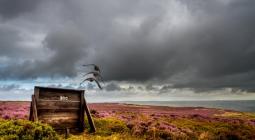How Earth Day 1970 Sparked a Lifetime of Environmentalism
On the very first Earth Day, a Montreal teenager helped organize a local event that set her on a lifelong path. Fifty-four years later, Carrie Buchanan—a retired reporter, professor, and editorial advisor to The Energy Mix—reflects on the moments and movements that shaped her journey.
In a church hall in Montreal’s suburban West Island on the evening of April 22, 1970, a group of teenagers, myself included, milled about setting up chairs, information tables, a film, a sound system, a podium for speakers. All that remained at this event marking the very first Earth Day was to see whether anyone would show up.
People did show up, and they were enthusiastic about our program, which we called Sewercide. It focused on water pollution, a salient issue in our community, Pointe Claire, located in the area called the Lakeshore, beside Lake Saint-Louis. Decades earlier, the lake had been a popular swimming destination for summer cottagers and day visitors from Montreal, but now it was fouled by untreated sewage dumped directly into the water as the population grew and grew. We called it Lake St. Pooey, and every summer, it stank.
Our Earth Day program featured speakers from the Society to Overcome Pollution (STOP), one of Quebec’s first environmental groups. We also showed a short film, The Rise and Fall of the Great Lakes, featuring renowned naturalist and author Bill Mason canoeing through pristine, then polluted, water. STOP had recruited us teens to help—a brilliant way to get us involved in a nascent environmental movement. For some, like myself, it became a lifelong passion.
That day, as it happened, I’d received a university acceptance letter accompanied by a generous scholarship. I made a commitment, then and there, to use my degree to help protect the Earth.
A Degree, a Detour, and a Turn Toward Journalism
In the 1970s, few universities offered environmental science majors. If you were lucky, they had one course. The “ecosystem approach”—examining entire ecosystems rather than isolated parts in separate departments—was considered new and unorthodox, though of course, Indigenous people had always taken that approach. Back then, university geologists studied rocks, biologists, living creatures, chemists, the underlying atoms and molecules, and physicists—well, I never understood what they studied. Never took physics.
By the time I graduated with a double major in biology and psychology, I needed a job and found one in a pharmaceutical research laboratory in Montreal. But it was 1974, and Watergate was unfolding in the United States. When the movie “All the President’s Men” came out in 1976, I felt called to journalism, hoping to write about public health and environmental issues.
I started out as a reporter for weekly newspapers in suburban Montreal—dragging my new husband, whom I’d met in high school, back to the very suburbs we’d just fled for the exciting city. The weeklies offered no science assignments, but I did receive on-the-job training while writing about school boards, crime, and local heroes.
A few years went by, we moved to Ottawa, had two children, and I became a full-time parent till they hit kindergarten. Our family spent time growing and harvesting organic gardens, hiking and camping, and learning to love nature. I was even a Girl Guide leader, encouraging girls to camp and explore the outdoors.
An interest in pesticides was sparked during those years, after our townhouse complex was sprayed with 2,4-D without warning during my second pregnancy. I developed a migraine and had to leave town for days. Frightened and outraged, I joined a group lobbying for a ban on the cosmetic use of pesticides. The city wouldn’t agree to it, but the school board did, bless their hearts. I would encounter that issue again in the year 2000, when I worked for the city’s public health department doing research for a possible ban. It didn’t happen, but the province of Ontario later read the same research and instituted one.
Digging Into Garbage and Covering Landfill Battles
In the mid-1980s, I returned to school to earn a master’s in journalism at Ottawa’s Carleton University. My thesis, a work of journalism, was about the garbage crisis that preoccupied the industrialized world at the time. I wrote about a fight in Bristol, Quebec, to prevent a huge landfill dump at a former open-pit iron ore mine—proposed by a single-minded entrepreneur, Maurice Lamarche, in partnership with Lavalin Corporation, then Quebec’s largest engineering firm. They did not anticipate the strong resistance of those rural dwellers, led by Bristol’s longtime mayor Jack Graham, who ultimately defeated the project.
While telling Bristol’s story, I wrote background chapters on the environmental dangers of landfills and incinerators—the latter was proposed for Ottawa, along with several dozen potential landfill sites, since the city had almost run out of space at its Trail Road site. The opposition was so fierce, in Ottawa as well as West Quebec, where Bristol’s potential landfill was among the proposed solutions to Ottawa’s garbage problem, that everyone demanded alternatives.
“We need a recycling program!” people said again and again at the public meetings. And along came the blue box recycling program, patterned on the German Grüne Tonne (the Green Bin program), which I travelled to Germany and Austria to see firsthand. It separated waste at its source, recycling and composting most of it and keeping landfilling to a minimum. And you know what? After doing that, Ottawa still hasn’t built a new landfill site, 40 years later.
When the time came to get a journalism job again, it was important for me to be neutral on the environment. Newspapers practiced “objective journalism,” which meant at the time that polluters got the same treatment as those who objected to their fouling the air and water. I knew I couldn’t do that, so I avoided the environment beat for years while I worked at the Ottawa Citizen, developing my objectivity with other topics. After years covering municipalities, I finally carved out a local environmental beat in the mid-1990s. I confessed to my longtime city editor that the environment was my deepest passion in journalism, but I’d not been able to admit it when I started, back in 1988. He replied, “It’s hard to believe that, back then, it was actually controversial to care about the environment.” By the 1990s, things had changed dramatically.
The Revival of Earth Day—and the Rise of Climate Denial
Earth Day in 1990 was a revelation. It was a huge, global event involving 200 million people, after two decades when few seemed to remember it at all. Resurrected by one of the original 1970 organizers, Denis Hayes, the event’s massive turnout and strong media coverage (which only happens when the community shows interest) evinced strong public support. As someone long accustomed to significant public apathy, even antipathy, toward environmental issues, I was astonished. Imagine my desolation when it turned out that the opposition would resort to anything, including fake science, to stop that momentum.
In the 1970s and 80s, significant progress had been achieved in fighting pollution, but by the 1990s, we were facing another threat: “global warming,” as it was labelled at the time. I remember how people made fun of it, remarking whenever it snowed that we could use that warming, which many considered either a fiction or something way too far off to worry about.
When You Wake Up And Smell The…
Gradually I realized, over decades when I earned a doctorate, a tenured professorship, and taught journalism and health/environmental writing for many years, that public support for environmental priorities is like the tide, rising and falling, again and again.
The key thing I learned from studying garbage was that people act when they face the consequences of inaction. We got recycling in Ottawa, and later composting as well, because nobody wanted a landfill or incinerator in their back yard. We got a crowd at that first Earth Day because nobody wanted to swim in Lake St. Pooey. In both cases, the unsavory consequences outweighed the costs of preventive, environmentally sustainable action.
Today we have unbearable heat waves, oceans warming dangerously and sea levels rising, out-of-control wildfires, and increasingly severe storms of all sorts. These consequences of climate change have convinced 80 to 89% of the world’s people today to support government action to prevent even worse consequences in years to come. That kind of public support is heartening to those of us who have spent decades on this slow-moving crusade. Now, we need governments everywhere to respect the people’s wishes.
Cover photo: At one of our favourite camping spots, Bon Echo Provincial Park in Ontario, in 1992. L-R: husband George, son David, daughter Sarah. (Photo: Carrie Buchanan)




